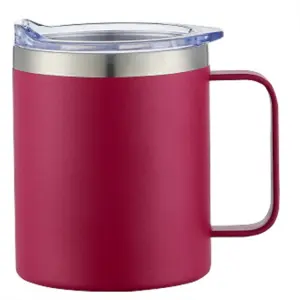In today’s fast-paced world, insulated travel mugs have become an essential tool for people who are constantly on the move. Whether it’s your daily commute, outdoor adventures, or just staying hydrated throughout the day, these convenient containers are a hit. However, concerns about their safety in holding water have surfaced. In this blog, we’ll look at the safety of insulated travel mugs, especially when used with water, revealing their reliability and potential risks.
Learn about the insulated travel mug:
Insulated travel mugs are designed to maintain the temperature of their contents for long periods of time. They feature double-wall construction that provides an insulating barrier against heat transfer, helping to keep hot drinks hot and cold drinks cold. While they are primarily used for hot drinks like coffee and tea, many people also use them with water.
Safety of water in insulated travel mugs:
1. Quality Materials: One of the key factors that determine the water safety of an insulated travel mug is the materials used in its construction. Look for cups made from BPA-free stainless steel or food-grade silicone, which are considered safe for storing water.
2. Leaching and chemicals: Insulated travel mugs made from inferior materials or substandard manufacturing processes may pose a risk of harmful chemicals leaching into the water. To reduce this risk, choose a reputable brand that adheres to safety standards and conducts regular quality inspections.
3. Temperature Control: While insulated travel mugs are effective at maintaining temperature, it’s crucial to avoid overheating liquids, especially when using them to hold water. High temperatures can damage the cup’s interior coating and potentially release harmful substances into the water. It is recommended to let the boiling water cool down for a few minutes before pouring it into the cup.
4. Harbors Bacteria: Proper cleaning and maintenance play an important role in ensuring the safety of the water stored in an insulated travel mug. As with any other container, residue from beverages or food can lead to bacterial growth over time, which can pose health risks. Clean your mug regularly with warm, soapy water and make sure it is thoroughly dry to prevent bacterial buildup.
5. Durability: Insulated travel mugs take rough handling, especially while traveling. Damaged or damaged cups can pose safety concerns because they can compromise the structural integrity of the cup or harbor bacteria in areas that are difficult to clean. Check your mug regularly for signs of wear and replace if necessary.
When used correctly, insulated travel mugs are generally safe for storing water. By prioritizing quality materials, ensuring proper cleaning and maintenance, and avoiding extreme temperatures, you can significantly reduce any potential risks. It is always recommended to invest in a reputable brand and pay attention to any specific user instructions provided by the manufacturer. By taking these precautions, you can enjoy the convenience and peace of mind of using an insulated travel mug to keep your water cool no matter where you go. Stay hydrated and stay safe!
Post time: Sep-18-2023
